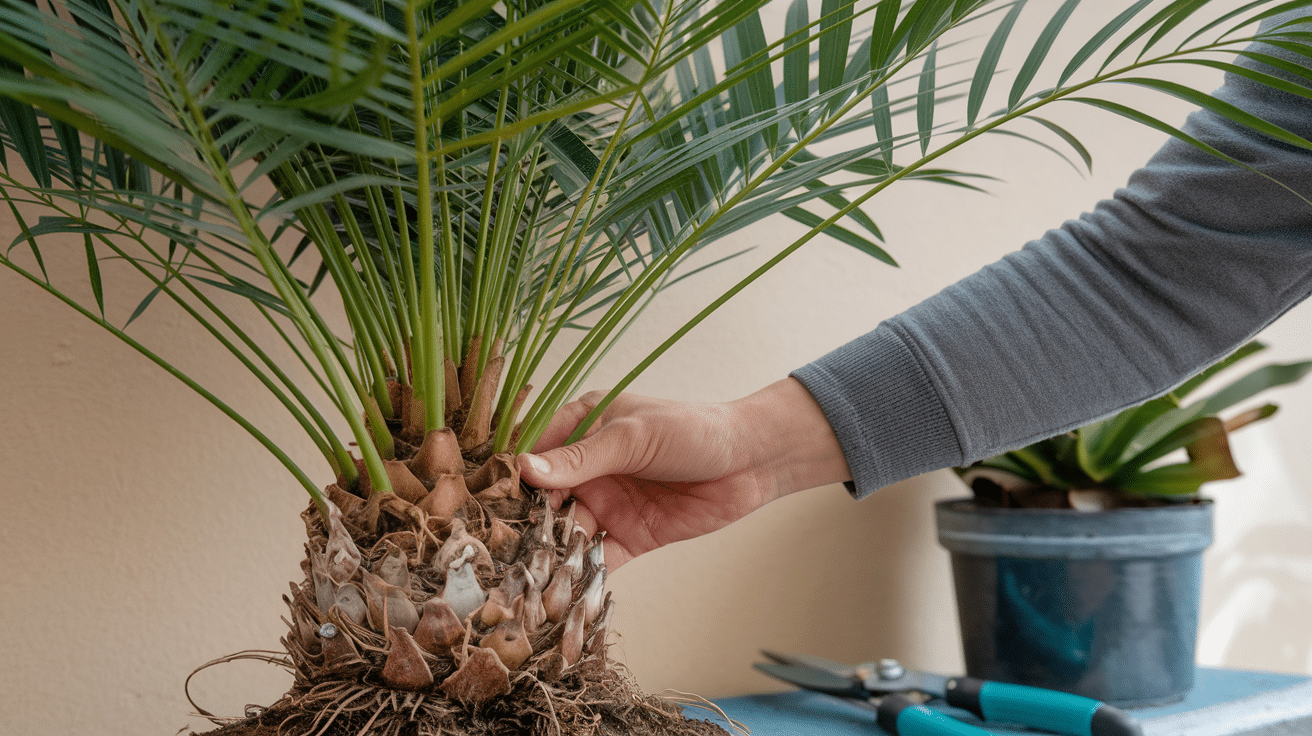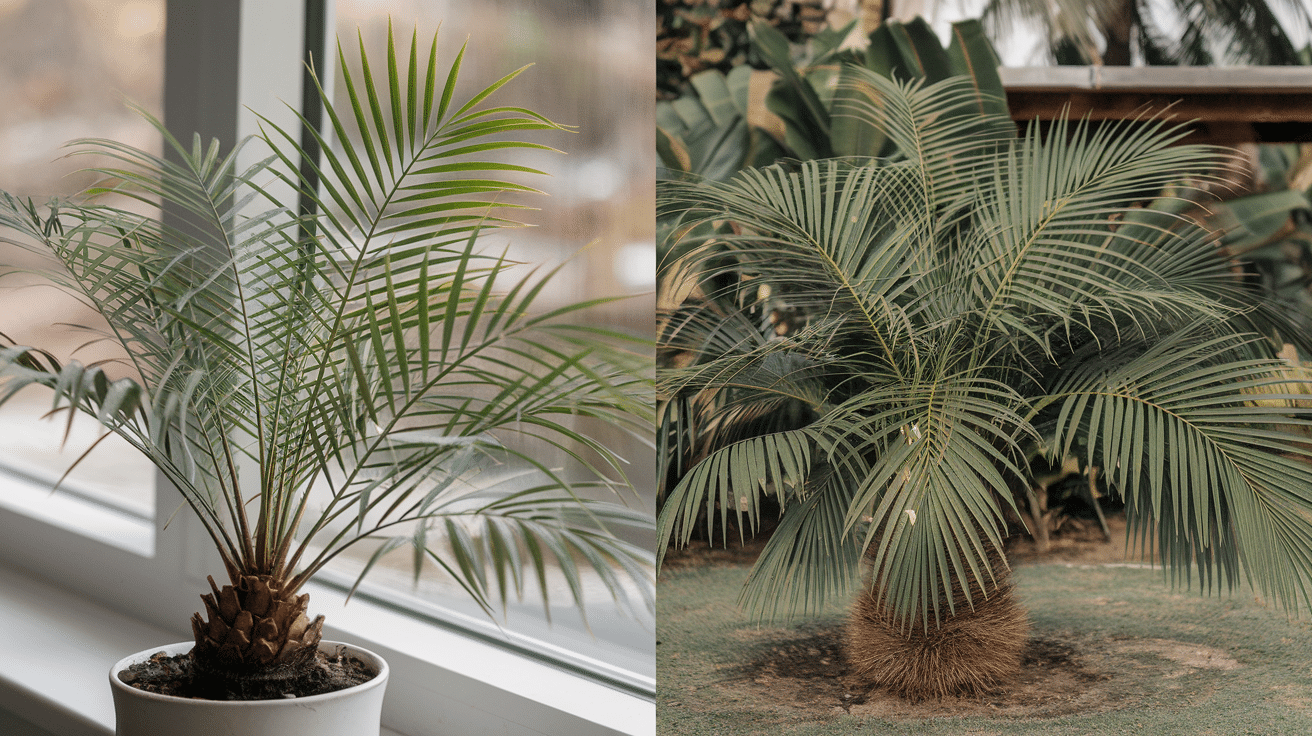So, you want a cool-looking plant that doesn’t ask for much? Meet the King Sago Palm. Now, don’t let the name fool you.
It may look like a tiny palm tree, but it’s actually a cycad. It’s happy chilling indoors or outside in your yard. Pretty flexible for something that’s been around since the dinosaurs.
But here’s the straight talk: It’s not totally carefree, it’s a slow grower. It’s kind of picky about light and loves good soil, and it’s definitely not pet-friendly.
Still, once you’ve mastered its basics, the King Sago is a breeze to keep alive and looking sharp.
In this guide, I’ll explain how I care for mine, what to do, what to skip, and what to watch out for.
Let’s dig in.
What is the King Sago Palm?
| Feature | Details |
|---|---|
| Common Name | King Sago Palm |
| Scientific Name | Cycas revoluta |
| Native Region | Japan and the Ryukyu Islands |
| Plant Type | Cycad (not a true palm) |
| Historical Background | Ancient plant group over 200 million years old, predating dinosaurs |
| Growth Habit | Very slow-growing |
| Ideal Climate | Warm, subtropical areas |
| Typical Use | Ornamental plant for gardens, patios, or indoors |
| Leaf Characteristics | Shiny, long leaves with spiny tips; arranged in a circular, rosette shape |
| Leaf Name Origins | “Cycas” from Greek “koikas” (palm tree); “revoluta” refers to curled edges |
How I Take Care of My King Sago Palm
Taking care of a King Sago Palm isn’t hard at all, as long as you keep a few simple things in mind. Here’s what I do to keep mine happy and healthy:
Watering (Don’t Overdo it)
I only water mine when the top of the soil feels dry.
When I do water it, I water it well, but I don’t let it sit in water. These plants hate wet feet.
So, make sure your pot has holes at the bottom. That way, extra water can drain out, and the roots won’t rot.
Sunlight (Bright but Gentle)
My Sago Palm loves bright, soft light. I keep it close to a window that gets filtered sun for a few hours a day, about 4 to 6 hours is perfect.
If the light is too strong or direct, the leaves can burn. I learned that the hard way once. Now I give it just the right amount of light, and it looks much better.
Temperature and Humidity (Warm and Cozy)
This plant likes it warm and steady. Mine does great when the temperatures stay above 60°F. If they drop below 15°F, it won’t do well at all.
So, if it gets really cold where you live, keep it inside during the winter. A little cold might be okay, but frost will mess it up fast.
Soil and Feeding (Keep it Light)
I use a light, sandy soil that drains well. You don’t want the roots sitting in soggy dirt.
When spring and summer come around, I feed it a little with a mild fertilizer. Just a bit, not too much. I made the mistake of overfeeding once, and it didn’t like that either.
Size and Growth of King Sago Palms
King Sago Palms can grow from 3 to 10 feet tall and wide, but indoor plants tend to stay smaller. This makes them perfect for both small spaces and larger gardens.
Slow Growth
One of the unique features of the King Sago Palm is its slow growth. It can take many years, even decades, for the trunk to grow from just 1 inch in diameter to 12 inches.
This slow growth makes it ideal for bonsai or for those who prefer slow-growing plants in their landscape.
Long-Term Care
So, your King Sago Palm is still kicking and slowly doing its thing. That’s good. Now comes the part where you play the long game.
These plants age like old trees (super slowly). That trunk will bulk up, but only if you’ve got patience and a steady hand.
Here’s how to keep it thriving year after year:
- Prune regularly: Snip off those dead fronds. Think of it as giving your plant a haircut – neat, tidy, and disease-free. Just make sure your shears are sharp and clean.
- Check for pests: Older Sago Palms can turn into a bug palace. Look out for mealybugs and scale insects, especially around the base. A quick spray of insecticidal soap should send them packing.
- Watch that water: Bigger roots need room and drainage. If water pools at the bottom of the pot or bed, the roots will rot. Make sure the setup drains like a champ.
- Size up the digs: If your Sago’s starting to look a little cramped, give it a roomier pot. Just don’t go too big too fast. Stick with something a couple of inches wider and keep that well-draining soil coming.
Take care of these basics, and your King Sago will hang around looking majestic for decades.
Propagation of the King Sago Palm

If you want more Sago Palms, you can propagate them in two ways: through seeds or suckers.
Seed Propagation
King Sago Palms produce cones with exposed seeds, and pollination occurs between male and female plants.
If you have both male and female plants, pollination happens naturally, and the seeds mature between September and October.
Once the seeds are ready, you can plant them to grow new King Sago Palms. This method requires patience, as the seeds may take several months to sprout.
Sucker Propagation
Sago Palms also produce suckers, or small offshoots, at the base of the plant. These suckers can be carefully removed and planted in new pots or garden spaces.
Suckers are an easier and faster way to grow new plants compared to seeds, as they are already partially developed.
Cut the sucker from the main plant, making sure it has some roots, and plant it in well-draining soil.
Both methods allow you to expand your collection, but sucker propagation is much quicker and simpler.
Pet Safety and Toxicity Considerations
Look, the King Sago Palm is a stunner but it’s got a dark side, especially if you’ve got pets roaming around.
Every single part of this plant is toxic. Yep, all of it. And the seeds? They’re the worst offenders. They contain a toxin called cycasin, which can cause everything from vomiting and diarrhea to full-blown liver failure in both animals and humans.
For dogs and cats, the danger is serious. We’re talking nosebleeds, bruising, bloody stool, the kind of stuff that’ll have you rushing to the emergency vet.
If you even think your pet got into the Sago, don’t wait. Call the vet right away.
How to Keep Pets Safe
- Put the plant somewhere they can’t reach. High shelves, closed-off rooms, whatever works.
- Got a curious chewer? Use barriers or just skip having the plant indoors altogether.
- Educate the kids too that this isn’t a “just pretty” plant. It’s a look-but-don’t-touch situation.
By taking these precautions, you can safely enjoy your King Sago Palm while protecting your pets and kids.
Common Problems (And What to Do About Them)
Even though the King Sago Palm is pretty chill once it settles in, it’s not totally drama-free. Like any good houseguest, it still needs you to pay a little attention.
Most of the time, this plant minds its business. But sometimes, Cycad Scale, mealybugs, or spider mites show up uninvited. These pests act like leaf vampires, sucking the life out of your palm one frond at a time.
Here’s how to fight back:
- Yellowing leaves? You’re probably overwatering. Ease up on the H₂O and make sure your soil drains well. No soggy roots, please.
- Pest infestation? Try wiping the leaves with a damp cloth for mild cases. If they’re not getting the hint, break out the insecticidal soap.
Growing Inside vs. Outside: What Your Plant Wants

The King Sago Palm is flexible and can live happily indoors or out. However, its needs change depending on where you plant it.
Growing Indoors
Sagos can totally handle indoor life, but they aren’t couch potatoes. They want light, filtered, bright, and about 4 to 6 hours a day. Stick them near a window that gets good sun without baking them.
Keep in mind: these plants like to spread out. So don’t shove it into a tight corner next to the bookshelf and hope for the best. Give it breathing room.
Also, indoor Sagos tend to stay smaller, which isn’t a bad thing. You won’t be fighting it for headspace anytime soon.
Growing Outdoors
If you live somewhere warm, think subtropical or tropical vibes, your Sago will love outdoor life.
Stick it in a spot with bright, indirect sunlight. Rock gardens, borders, or sloped spots that drain well are perfect.
Outdoors, it gets to stretch its legs (well, roots) and show off. Just make sure it’s protected from frost. These plants may look tough, but they’re not into cold weather.
Why Bother with a King Sago Palm?
Alright, we’ve talked about care, drama, and pet safety, so why bother with a King Sago Palm? That’s a good question.
Here’s the payoff:
- It looks sharp. Those glossy, feathery fronds give it serious style points. Indoors or out, it brings a bold, tropical vibe—without going full jungle.
- Air purifying. Like a lot of houseplants, it helps clean the air. One less reason to worry about that mystery smell in the living room.
- Low-maintenance. This plant grows at a snail’s pace and doesn’t need constant fussing. Perfect for folks who want green without the guilt trip.
- Durable. The Sago Palm is no seasonal fling—it’s in it for the long haul. With the right care, it’ll be with you for years.
- Indoor or outdoor, it’s not picky. Want it in the living room? Cool. Garden bed? Even better. It can handle both, as long as you give it what it needs.
- Safe for humans. Sure, it’s a no-go for pets. But for humans? Totally fine to touch, admire, and brag about to your plant-loving friends.
Final Thoughts
The King Sago Palm is a beautiful plant that can beautify any room or garden.
With just a little attention, like providing the right light, watering properly, and trimming dead leaves, you can enjoy this unique plant for many years.
Its slow growth and low maintenance make it a great choice for beginners and experienced gardeners alike.
If you’re looking for a durable, eye-catching plant, the King Sago Palm is a perfect addition.














One Response
Mr. Lemmon,
My name is Kerri I run a landscaping company with my son and I was wondering what caused caladiums to fall over to the sides of the plants? Is there anything we can do on our part to prevent this from happening or is there something we can do to help keep them pirky, standing up and beautiful for our customers that want them in their landscaping before and after we plant them? I’ve used straws cut down the side to slip around those weaker stems to hopefully give them a change to strengthen that are weak when we buy them from the nurseries and for those that have already been put in the ground or pots in our customers landscaping. Some strengthen over time with that support, but others never manage too, even the hose with smaller leaves that just sag and lay over from the start while growing out.ive often wondered if there’s anything I can do to help them stand up, but haven’t really found a good remedy for this problem. I found you while searching something for another plant online and thought I’d take a chance and ask you about this issue with the caladiums. Hopefully you can give me suggestions on what may help or what causes them to lay over, even the young shoots, sometimes even before the leaves unfold. I would really love to hear your solution or any insight you may have about them. It’s really embarrassing when the customer asks me about them and why some of the plants seem weak and lay over like they do and all I can say is some just do that, that sometimes they grow with weak stems or that the weight of the big leafs pull it down because of their weight. Some are satisfied and some just look at me like “sure, ok if that’s your answer”, meanwhile not believing me or look at me in dismay or give me that “you’re not so knowledgeable and informative with some of the plants you suggest is to have in our landscape” look. Anything would be appreciative that you may have to suggest or educate me with.